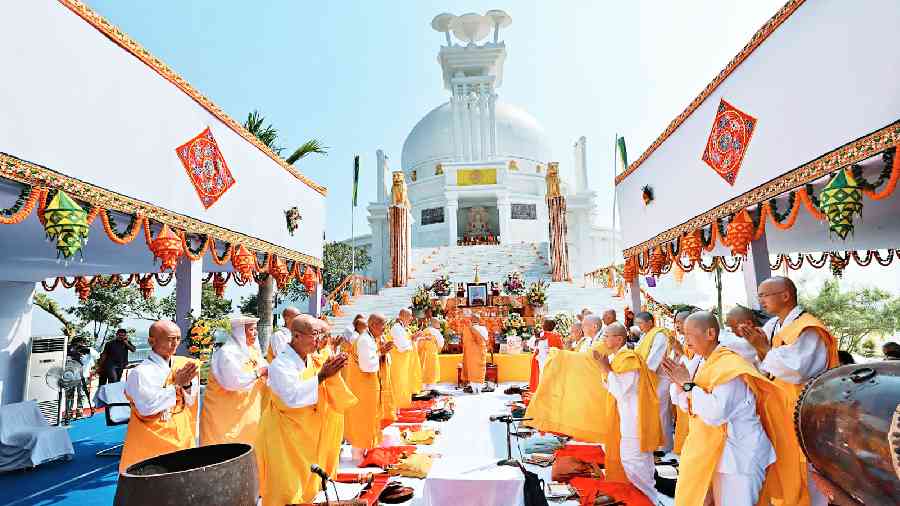Hundreds of monks from across the globe thronged the famous Dhauligiri Shanti Stupa Pagoda, a symbol of peace associated with the Buddhist culture, on the outskirts of Bhubaneswar to mark the golden jubilee celebration of the monument on Friday.
The dome-shaped stupa atop the Dhauli hill on the banks of river Daya, about 10km from here, recalls the famous Kalinga war and the transformation of king Ashoka from a tyrant into a benevolent monarch. However, the monument remained neglected by the authorities for a long time.
The stupa was built jointly in 1972 by the Japan Buddha Sangh and the Kalinga Nippon Buddha Sangh. It was constructed under the supervision of the chief priest of Nipponzan Myohoji, Nichidatsu Fuji Guruji of Japan, who came to India in the early part of 1930s from Mt. Minobu in Japan, the original holy place of the Nichiren Sect. In late 1960s, he was requested by the Buddhist monks to set up a stupa here. Following a request from Buddhist monks, the Odisha government also agreed to provide land for the monument. He stayed at the Dhauli hill, which was revered by Buddhists because of the legend that king Ashoka had converted to Buddhism in the wake of Kalinga war here.
Here Emperor Ashoka is believed to have renounced violence after watching the bloodshed in the battle of Kalinga fought in the foothills of Dhauli and adopted non-violence after converting into the Buddhist faith.
The famous Ashokan edicts enshrining his decrees for the welfare of people and even animals within his empire are still treasured at a site close to the base of Dhauli hill. The pagoda on the hilltop is adorned by the statues of the reclining Buddha, an elephant procession, the Bodhi tree, and footprints of Buddha bearing the chakra (wheel).
Taking part in the celebrations, Odisha chief minister Naveen Patnaik said: “Let us work together to spread the message of peace and create a safer world for our future generation.”
Delving into the glorious history of Odisha, he said that the state’s history starts with Dhauli and the Kalinga war. Although the war ended with massive bloodshed, Dhauli continues to sing about the moral victory of the entire humanity. “It is this place where Ashoka realised the futility of war and bloodshed and embraced Buddhism. In fact, Dhauli changed the course of world history by spreading the message of global peace and harmony,” Naveen said.
Stating that Dhauli Peace Pagoda is a great creation of modern architecture, Naveen said: “It bears testimony of Indo-Japanese friendship that stands for global peace and mutual cooperation. The place will continue to spread the message of peace for all the time to come.”
Offering tributes to Fuji Guruji, he said: “On the eve of this momentous occasion, I offer my sincere tributes to most revered Nichidatsu Fuji Guruji of Japan, Founder and Preceptor of Nipponzan Myohoji, for his invaluable contribution in building this “Biswa Shanti Stupa” at Dhauli. Further, the steps taken by Kalinga-Nippon Buddha Sangha to make it happen is also appreciated.”
Naveen also announced the construction of instream storage on the Daya. The estimated cost of the project is Rs 95 crore.










